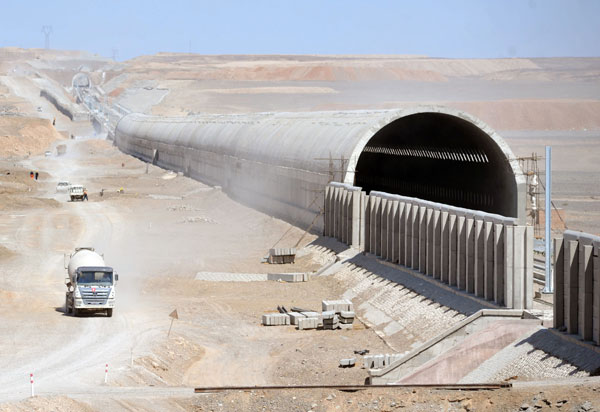Challenging times on 'high-speed Silk Road'
Updated: 2013-07-12 07:38
By Cui Jia (China Daily)
|
||||||||
Wind zones
In Xinjiang, strong winds are a major threat to the safety of the high-speed railway, according to Ma Xizhang of the project management department of Xinjiang Lanzhou-Urumqi Railway Co, which is responsible for construction of a 710-km stretch of railway in Xinjiang.
 |
|
China's first windproof railway tunnel, in the Shisanjianfang district of Hami, where the winds are fierce and gales occur on more than 250 days of the year. |
The high-speed railway will pass through three of the region's most-feared areas, where winds traveling at speeds of up to 166 km per hour regularly disrupt operations on the old Lanzhou-Urumqi railway and have even been known to overturn trains.
"The nature of the high-speed railway means the threat posed by the wind is much higher than for a conventional railway, so windproofing projects are crucial to its success," said Ma.
Earlier this week, China's first windproof railway tunnel was completed in the Shisanjianfang district of Hami, where the winds are strongest and gales occur on more than 250 days of the year.
Without citing a specific figure, Ma said the construction costs were high but the 1-km-long tunnel is essential. "When the company's inspection team arrived in the area in 2010, the windows in their cars were smashed by stones carried on the sudden, strong winds. If that happened to a high-speed train, it would be a disaster."
More than 65 percent of the Lanzhou-Urumqi high-speed railway in Xinjiang will cross these wind zones. In addition to the tunnels, windbreaks are also being erected to further ensure the safety of the trains. The scale of windproofing is the largest of all the high-speed railways currently under construction in China.
Most Viewed
Editor's Picks

|

|

|

|

|

|
Today's Top News
Saudi princess charged with US human trafficking
Asiana takes out apology ad in Chinese media
Asia spending too little on poor: report
Constructive mood at Sino-US talks
China, Russia consider increasing naval drills
No mechanical trouble on Asiana
More Americans favor immigration
Increased cooperation brings benefits
US Weekly

|

|














